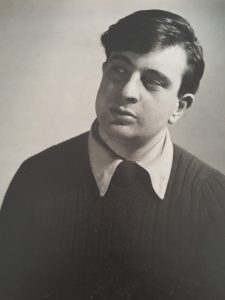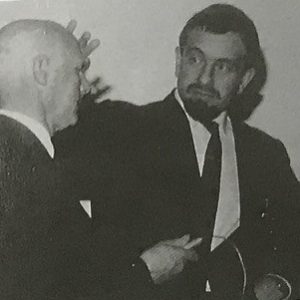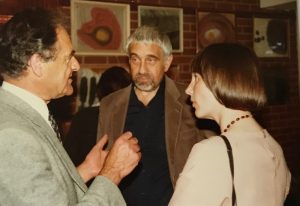Use these links to jump down the page:
Sidney’s Early Years
A Career in Natural Medicine
Acupuncture
Tyringham Naturopathic Clinic
Family Life
Illness and After
Sidney’s Early Years

Sidney was born in London on 20 June 1926. His parents, Samuel and Rebecca, had met in Hull after fleeing the pogroms in Poland. His father continued his journey to relatives in the USA and was in California six weeks after the great earthquake of 1906. He returned to England to marry Rebecca. Sidney was the youngest of four children, three boys and a girl. His family lived in Dalston in the East-End of London – an area that has since gone through significant gentrification, but was a much poorer part of the city at the time.
In 1928 tragedy struck when his eldest brother died aged 10 and his father’s factory burned to the ground, leaving the family in straitened circumstance. In Sidney’s early childhood the family could afford a few luxuries including the occasional holiday, but life changed from this event on. Sidney later told stories about his father working such long hours trying to rebuild their lives after the fire that he would often fall asleep at the dinner table from sheer exhaustion, laying his head down on the newspaper that served as a table cloth.
Sidney was academically extremely gifted and attended Grocers School. With the family finances in difficulty, he had to turn down scholarships to attend two private schools and instead start work as an apprentice cabinet maker at age 14. By his mid-twenties Sidney owned several successful furniture making businesses, had the contract for refitting Chatham Dockyards and designed furniture for Harrods. He also owned dance halls in Ashford Kent where musicians who are now household names appeared. His capacity for hard work was reinforced by the fact that he only slept for four hours a night (something that continued throughout his life).
A Career In Natural Medicine

In 1950 he turned his back on his business interests. A strong social conscience and an interest in natural medicine drove Sidney to pursue more altruistic endeavours. With the help of his first wife Mary, he commenced studies at Regent St Polytechnic and four years later graduated with dual qualifications in naturopathy and osteopathy and membership of the British Naturopathic and Osteopathic Association.
Sidney set up a successful private practice in London which he maintained on a part-time basis for the rest of his working life. His income from his private practice enabled him to work for very low remuneration at the charitable foundation he established at Tyringham. After he had finished working at his practice he often served meals for the rest of the night to the homeless at Centrepoint alongside his friend, one of the charity’s founders, Father Bill Kirkpatrick.
In 1958 Sidney attended a conference in Germany with his friend and colleague Kenneth Basham where they were introduced to acupuncture. Sidney was intrigued by a stand with the word ‘Acupuncture’ on it. He said later that he was actually interested in hydrotherapy and mistook Acus (needle) for Aqua (water). However, he was hooked. He was fluent in French and German and began intensive study of acupuncture in Germany under Dr Gerhard Bachmann, founder of the German Society for Acupuncture, between 1958 and 1962. He went on to achieve a Doctor of Acupuncture qualification. During these intense years of studying Sidney also gained qualifications in medical biology and chiropractic.
By the early 1960s he was recognised as a leader in the field of osteopathy and was presented with the International Henry Jaume prize for Osteopathy in both 1960 and 1961.
Some of Sidney’s many other professional roles and involvements included:
- Adviser on behalf of the British Acupuncture Association to the State Board of Chinese Medicine, Nevada
- Adviser on behalf of the British Acupuncture Association to the Corporation of Physicians, Quebec
- Adviser on behalf of the British Acupuncture Association to the Ministry of Health, Israel
- Chairman of the Editorial Board of the British Journal of Acupuncture
- Fellow of the Royal Society of Health, UK
- Fellow of the Acupuncture Foundation, Sri Lanka
- Fellow of the Acupuncture Foundation, India
- Member of the British Association of Humanistic Psychology, UK
Read more about Sidney’s publications here.
Acupuncture

After studying acupuncture intensively in Germany, Sidney began to use his new skills in his practice in London.
In 1962 Kenneth Bashan and Sidney organised a three day seminar in London where lectures were given by leading acupuncturists including Denis Lawson Wood, Leslie Korth and Nicholas Sofroniou. The course was attended by 68 naturopaths, osteopaths, chiropractors, doctors and physiotherapists, Amongst those who attended were some of the key figures in the development of acupuncture in Britain including Malcolm Stemp, J.R Worsley, Royston Low, Dick van Buren and Mary Austin.
Sidney felt strongly that for the profession of acupuncture to gain credibility and respect in Britain it required a regulatory body and educational standards. From these beginnings various influential groups were formed in the UK. Sidney was subsequently one of the prime movers in forming the British Acupuncture Association and Register, of which he was Chairman for many years. During this time he forged close links with acupuncture associations and professionals around the world. Amongst his close friends and colleagues from overseas were Oscar Wexu (first President of the International Organization of Acupuncture Associations), Jean Schatz (President of the S.I.A.), Nguyen Van Nghi (Vietnamese-French physician who was prominent among those credited with bringing Chinese medicine to the West), Michio Kushi (Japanese scholar who popularised the macrobiotic diet in the United States), Dr Agrawal (Indian doctor and author of the textbook “Clinical Practice of Acupuncture” who named a ward of his hospital after Sidney), Arthur Koestler (Hungarian-British author and journalist) and Anton Jayasuriya (Founder of the Sri Lanka Acupuncture Association).
Following the establishment of the Acupuncture Association, Sidney was integral in setting up the British College of Acupuncture in 1964 whose role was to provide postgraduate training and examinations for practitioners.
Sidney was dedicated to promoting acupuncture and natural medicine, and lectured widely both in Britain and internationally. He was a world figure in the field of acupuncture and gave talks in many countries including China, Sri Lanka, Hong Kong, Singapore, the Philippines, Japan, Canada and the USA. Sidney also had several meetings with Dr Bannerman at the World Health Organisation in Geneva as well as meeting him at other international conferences to discuss the promotion of acupuncture at a global level.
In 1976, he was invited by the Chinese government to take ten members of the British Acupuncture Association to visit Chinese colleges and hospitals where traditional medicine was practiced. They were the first foreign delegation to visit China to study acupuncture treatments since the Revolution.
Sidney wrote several books including “Acupuncture and the Life Energies” and “An Acupuncturist Visits China”. He also wrote more than 200 articles about traditional medicine for magazines, and gave countless television and radio interviews. Sidney was recognised as one of Britain’s foremost advocates for traditional acupuncture and was widely sought after as a spokesperson for the profession.
He was particularly drawn to Sri Lanka which he visited many times to see his close friend S.D. Bandaranaike M.P. (whose daughter Sharmala eventually studied acupuncture and worked at Tyringham Clinic). If his illness had not made it impossible, Sidney wanted one day to retire to Sri Lanka and establish a college and clinic there.
Tyringham Naturopathic Clinic

Sidney had become convinced of the value of a range of holistic treatments and began visiting many spas and hydros in France, Germany and Italy. He was also driven by the need to make these treatments affordable to all strata of society. The opening of Tyringham Naturopathic Clinic in the Buckinghamshire countryside in 1967 was the realisation of his dream.
Alongside his second wife Wendy and with the support and assistance from his great friends and philanthropists Sir Maurice and Lady Hilda Laing, Sidney established Tyringham as a non-profit charitable foundation to provide low cost natural treatments available to all, regardless of income.
The work and contributions of the staff and benevolent friends ensured the successful launch and continuation of Tyringham. The list of friends involved is long but included Phil and Pat O’Connell, Esther Sarna, Godric Bader, Alf Youell M.B.E. and Valerie Youell, John Michie M.B.E., Joe Mearns, Leslie and Doreen Swanne, Charles Varney, Sir George Grenfell Bains, Roger Newman Turner and many members of the various healing professions and organisations and the board of Tyringham. They all worked and contributed without recompense to ensure the survival and success of a dream they shared.
The residential clinic had 100 beds and offered a wide variety of treatments including acupuncture, osteopathy, naturopathy, hydrotherapy and herbal medicine. Sidney had studied extensively the health benefits of a plant-based diet and all food provided at Tyringham was vegetarian, with much of it raw. The clinic was housed in a beautiful Grade 1 listed stately home designed by Sir John Soane in 1792 with later additions by Edward Lutyens, and set in 30 acres of landscaped gardens and woodland.
Sidney worked tirelessly at the Clinic, both in his work as the Director and as a practitioner providing treatments to thousands of patients. His ability to heal, attentive manner, mischievous humour, and undeniable charisma, but particularly the alleviation of their symptoms, prompted many patients to return.
Sidney was very much loved by both patients and staff and it was a terrible loss when he had to stop working due to ill health. He did so well at great personal cost to translate his dream into reality. Despite the valiant efforts of many dedicated people after his leaving, the vision eventually blurred, the momentum was lost, and Tyringham Clinic was closed in 2001.
During its lifetime Tyringham helped countless people, many of whom had not been relieved by other treatments, and it is not coincidental that many of the ideas concerning health which were regarded as fanciful, if not quackery in the 1960s, have since become mainstream.
Read more about Tryingham Naturopathic Clinic here:
- Article written by Wendy Rose-Neil about Tyringham Clinic
- The Tyringham philosophy of natural health
- Treatments offered at Tyringham
- Photos of Tyringham
- Testimonials about Tyringham
Family Life

Sidney married three times.
He married his childhood sweetheart Mary in 1947 who supported him through his training and establishment of his practice. Although they divorced after 19 years of marriage they remained close friends until her death.
He married his second wife Wendy in 1966. They worked closely to continue his private practice in London and to set up Tyringham Clinic together. Sidney and Wendy lived at Tyringham with their two daughters, Sasha and Justine, and the whole family was closely connected with the everyday life of the Clinic for many years.
Sidney married Pat in 1977 and their strong partnership was the backbone of his later career and international work. They had one son, Philip, who has followed in his father’s footsteps as an acupuncturist.
Despite Sidney’s charismatic personality and seemingly outgoing nature, he was actually a very private person. He relished quiet time with his family and looked forward to holidays when they could be together undisturbed and away from the demands of his busy professional life. His love of woodworking continued throughout his adult life. Spare time was rare and precious as he got older, but when he could find an hour or two at the end of the day he would relish the inner peace he found making furniture and listening to classical music in his garden workshop. He was keenly interested in antiques and had great skill in interior design.
Illness and After

At the age of 54 Sidney’s professional life was cut abruptly short when he suffered a series of devastating strokes as a result of polycythaemia. He was left partially paralysed and with little speech.
Sidney dug deep and was able to walk again and he became an expert at one handed cooking. He determinedly undertook many years of speech therapy and regained a small number of words whilst also learning to work with other methods of communication to convey his thoughts. Sidney was often hugely frustrated by his lack of speech however he ensured his voice remained profound and loud.
His family adjusted over the next seventeen years so that communication was only interrupted in the car at night when sign language was difficult, not to say dangerous! At his funeral attended by hundreds, at least half of the attendees had become friends after his illness and felt they had had meaningful communication with him.
Sidney travelled extensively in Europe after his illness and attended conferences in Sri Lanka and China.
The need for a continuing purpose combined with a yearning for self-expression became increasingly important to Sidney. He had never painted before but in the years following his strokes he discovered a new path in life as an artist. He had a studio in his Northampton garden and he spent his days painting images of the complex thoughts he now found it so much harder to convey.
Through his paintings Sidney communicated his inner thoughts about the connections between living matter, between good and evil, between Yin and Yang.

Sidney had done much research into colour therapy before suffering his stroke, interpreting these relationships in terms of the Yin and Yang principle: the most neutral colours give a feeling of peace because they incorporate the purest balance. According to Chinese belief, when Yin and Yang flow in harmony there is health, when they are in revolt there is disease.
Sidney’s art became central to his final years. His skill was rewarded with several small art exhibitions, but most importantly he found a new purpose and powerful means of self-expression.
Click here to see examples of Sidney’s art.
His initial life expectancy following the onset of his illness had been seven years. Seventeen years later, at the age of 72, his polycythaemia changed to leukemia. His health declined rapidly and he died from heart failure at home in Northampton on January 27th, 1999. He sadly never met any of his four grandchildren, Alex, Sophia, Teddy and Benny.